After Billy attended the press launch, we wanted to take a closer look at Suzuki’s new small-displacement machine, the GSX250R. This bike is powered by a 248cc parallel-twin, fuel injected engine and features a full fairing that gives it a look reminiscent of Suzuki’s larger-displacement sport bikes.
Like other small-displacement sport bikes from competitors, the GSX250R has a practical, upright seating position, rather than the more aggressive position found on its larger siblings (with much lower bars and foot pegs placed several inches rearward). The aim, apparently, is new riders, as well as those looking for a practical, yet fun machine. Indeed, Suzuki says the GSX250R draws more heavily on its Katana heritage of general purpose bikes.
Practicality is aided by excellent fuel economy. We easily exceeded 60 mpg despite “wringing the neck” of the small engine during our testing, just as any competent journalist would. Together with a four gallon fuel tank, the machine offers enough range to surpass the expectations of most riders … and their endurance between stops.
With that four gallon fuel tank topped off, Suzuki claims a curb weight of 392 pounds. Not the smallest machine, but the seat height is reasonable at 31.1 inches, and the slender nature of the bike between the riders’ legs will allow even shorter riders to touch down at stops.
With a six-speed transmission, non-adjustable KYB suspension, disc brakes and cast aluminum wheels, there is nothing that particularly stands out on the GSX250R from a chassis perspective. Typical for the small-displacement category, there is only a single disc brake up front.
Tubeless tires measure 140/55 x 17 in the rear and 110/80 x 17 in front. With the increase in small-displacement models available in the U.S., there is a corresponding increase in available tires that will fit the GSX250R.
Engine performance for a 250cc twin is more than decent. The GSX250R provides a somewhat surprising amount of low-end and mid-range, seemingly aimed at new riders and commuters. A linear delivery sees power build as the tach rises towards the 10,500 rpm redline. The six gears are spaced relatively close, as we saw 86 mph in sixth gear at redline.
The non-adjustable suspension has been tuned very well by Suzuki, and offers a relatively plush ride while staying reasonably controlled as the pace rises. Together with the smooth engine, the GSX250R always felt composed on the highway.
On twisty roads, the GSX250R is nimble enough given its relatively low weight and narrow tires, while feeling more stable than some of the competition. It rides a bit like a bigger bike, i.e., with smooth archs and unruffled manners. The front brake is merely adequate, however, for more spirited riding, and can fade much quicker than a twin disc setup.
We found comfort on longer rides pretty good, although the reach to the bars is a bit further than some of the other bikes in this category. The smooth engine means the mirrors remained buzz-free, for the most part, and they are positioned wide enough to provide a clear view.
Altogether, the 2018 Suzuki GSX250R has a well sorted, refined character that should serve new riders well, while providing a practical option for experienced riders that want a small-displacement machine in their stable. The challenge for Suzuki, perhaps, will be finding its niche in an ever-expanding crowd of competitors.
Priced at $4,499, the GSX250R twin offers more engine performance than the 286cc single-cylinder Hondas, the CBR300R and CB300F, both of which are priced close to the Suzuki. Larger displacement twin-cylinder alternatives from Kawasaki (the new 399cc Ninja 400) and Yamaha (the 321cc R3), will each be priced starting at $4,999. Both of the Japanese competitors with twin-cylinder engines should offer substantially more peak horsepower than the GSX250R, however.
The 2018 Suzuki GSX250R is available in Pearl Nebular Black (shown) and Pearl Glacier White. Take a look at Suzuki’s web site for additional details and specifications.
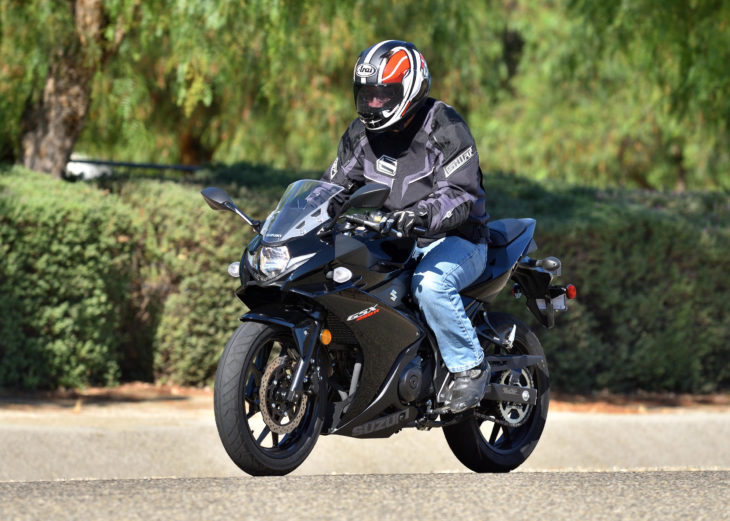
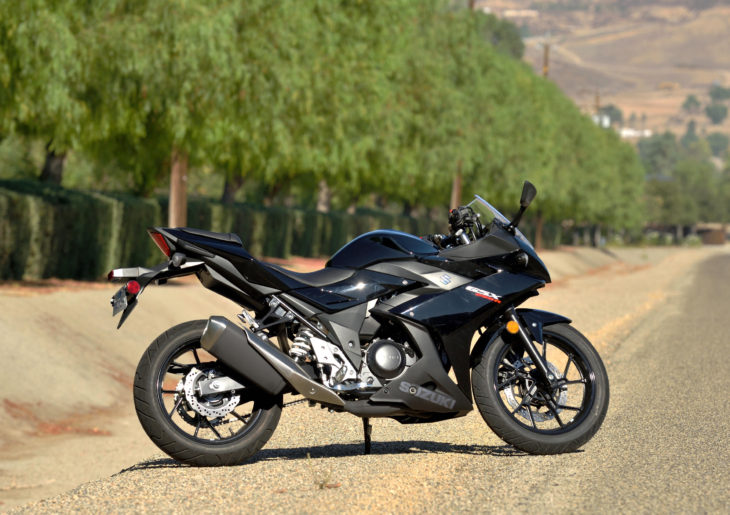
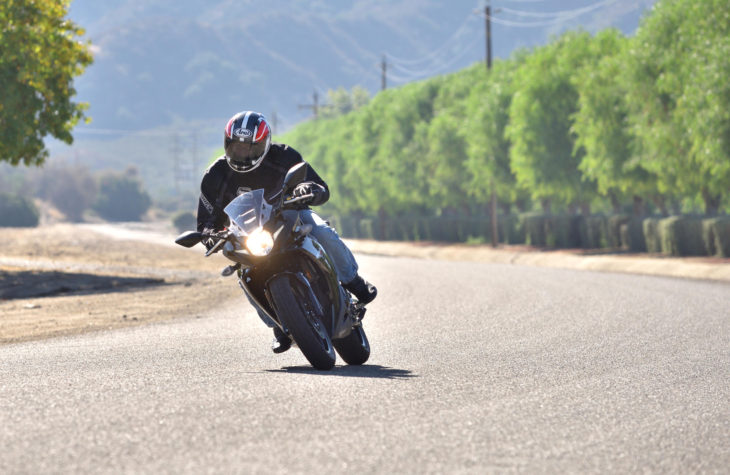
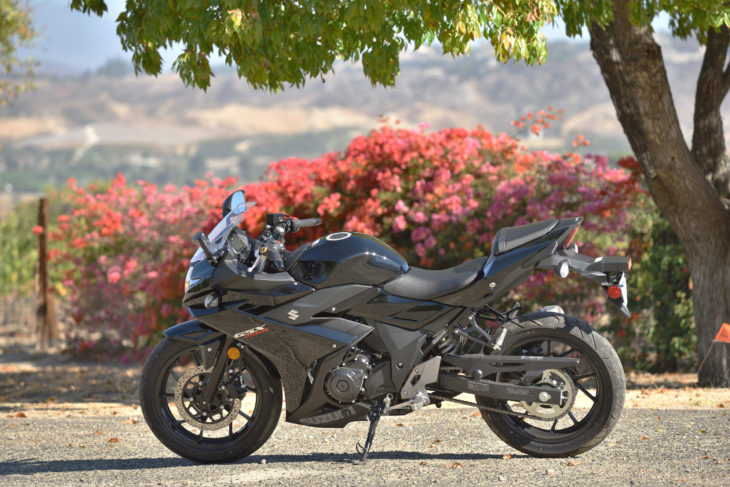

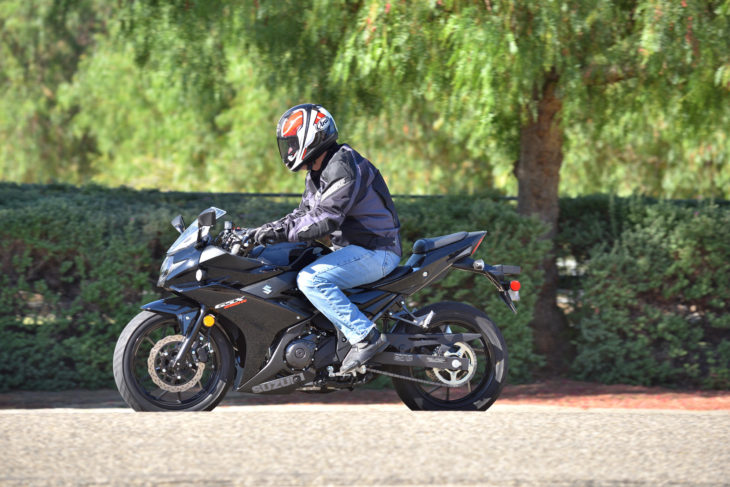






It’s almost like Suzuki is doubling down on the TU250 which was a decent bike that was or will be a big seller. And now that the GS500 is gone then why not replace it with a modern version?, that’s really what this is. And knowing that the Adventure market is still climbing that replacement needed something that could be converted to ADV status. Suzuki admitted that when the released the V-Strom 250, problem is that in the US market it needs to be a 400 or 500 cc sized machine “minimum” to be taken seriously.
Seems to me that Kawasaki has thrown a bucket of cold water on the 250cc market with their 400. For anyone wanting a small bike but worried that a 250 might not be the ticket for the highway portions of their rides, a 400 would be perfect.
I like this new Suzuki. I have sat on it and it definitely is one of the best in class for style
and based on this article it preforms well. Many of the comments made by the “bench racers” ( bench warmers ) is just typical in our country where we have been weaned on more is better. There are 3 motorcycles in my garage and the smallest one, a Honda CBR300 is an absolute hoot to ride. You haven’t had fun until you ride one of these at WFO and lay to waste pretty much anything going through a corner. Less is more my friends.
The Reader comments which are basically “Not for Me” are because of previous experience or bias.
The Reviewer indicated the motor is very good for it’s size, the suspension is spot on, it’s fully faired, so why be so harsh?
A personal test ride could convince you that you could save some precious Dollars if you were about to purchase a bigger capacity bike. Remember bigger cc = more cost and a steady running speed, compared to acceleration, does not require a lot of HP.
“why be so harsh?”- we got nothing better to do. It’s too cold to ride. I don’t have Netflix. I’m bored.
Looks like Honda is going to give their Neo treatment to the 300 at least in the UK. Is Suzuki a day late and a dollar short with this? Most salesmen will try to talk you out of buying anything with a small displacement for a first bike. You’ll get tired of it in a month. Maybe they’re right. Texans usually drive 80-85 so none of the above is good on the interstate.
Can a large displacement bike with a beginners mode in its electronics be the answer to the dilemma? Big vs small.
This looks like a very nice motorcycle. It appears large enough to accommodate a normal American rider. It purports to be frugal at the pump and has a 4 gallon tank to get you where you’re going and back again if the round trip is within 300 or so miles. It looks great too and should serve both beginner and any reasonable adult that sets their ego aside when riding on the street.
What then makes this bike the target of the ire of so many Motorcycle Daily readers? It’s “only” a 250. Puhleeze. It is not too late for Suzuki to bring a 250 bike to this class, especially one as nicely done as this one is. “But…But…But…It’s only a 250 and other bikes are in the 300 class and above!” some here whine. Everyone has a big but, let’s talk about these readers and their big but.
The Suzuki GSX250R is an fine all around street motorcycle (especially so for newer riders) unless the only thing bigger than the combined buts (butts?) of these readers is your ego. People asked for a resurgence in the 250cc class and now want that class to keep moving up in displacement to support their big buts. And egos. Reading the hilarious commentary by these bench racers extraordinaire makes one wonder why any manufacturer sends anything smaller than a 1,000cc bike making 200 RWHP and weighing in at under 350 lbs. with the more than adequate for these manly bunch of sweaty mens, 2 gallon fuel tank topped off to the USA is a mystery worthy of a Dashiell Hammett novella.
There is obviously a need not only for tiered licensing in this nation but also tiered typing. And many of you comment on how HD riders need their egos stroked by their machinery? WTF indeed. Great bike Suzuki. Hopefully it will find an audience in the USA that will grow in experience with the passage of miles and years and when they are truly ready, move up to a larger motorcycle without the baggage of that big but that is so prominently on display by some of these readers.
“Tiered typing” … good one.
Having owned a CB250 back in the day and a 50cc 4-stroke scooter currently, I do think that Suzuki miscalculated on the engine displacement. With many present-day cars producing over 200hp, I have found driving a slow vehicle of any sort to be frought with challenges on city streets and freeways. Basically, you’re forced to assume a defensive posture in gaining access to open space or navigating through traffic. It’s a handicap that doesn’t need to be there. I think Kawasaki has recognized this fact and given their small machine a little extra much needed torque by nudging displacement. Suzuki should do the same.
No. No one (in North America) asked for a resurgence of 250 cc motorcycles where they are not practical for larger roads. What they asked for and what the market is delivering is a resurgence of middleweight bikes. Suzuki used to have a 500, no more. Its not an ego thing, its a balance. Bikes got monstrously huge and now pendulum is swinging back to a configuration that balances performance with practicality.
The CBR300R from a review of online testing nets 26.2 hp and 17.4 ft-lbs of torque,to the GSX250R’s 19.2 hp and 13.7 ft-lbs of torque. On the same dyno with the same as publication. Yet, you say that the GSX250R offers MORE engine performance the the CBR300R siblings!?! The CBR300R also weighs 32 lbs less!!
Agree. The CBR300R/F is far more interesting to this egotistical power mad sweaty man!
A bike as nice as this little SUZUKI deserves at least competitive power. If it was in the same HP ballpark as the other bikes in this class it would be much more interesting. I did ride a Ninja 250 and it took a lot of RPM’s to get anywhere. Sometimes bigger is better.
We (my wife and I) had a first gen Ninja 250 for a while as her bike. I did take it for a few long rides and really wished I was on something a little stonkier (and better handling). My wife never really was comfortable with it’s weight and bulk. She is 5’3″ and 115 pounds. I’ve sat on and pushed around the CBR250R and thought it would be more manageable for her. Right now we have a very suspension modified WR250R with a 32″ seat height that is supposed to be her bike, but once again she isn’t “bonding” with it. Visually it’s a ugly dualsport, and I think that’s part of the problem. The CBR250/300 are “prettier” and I guess either would work for her. The 300 would be the more interesting bike to me but it would never be my primary bike.
So, the new GSXR appears to be down on power to the EX250, and 30 pounds heavier. It seems like all Suzuki really did is make sure it’s a nice looking bike. Overall that’s just a fail to me.
I had a Kaw 350 3 cylinder two stroke that would empty a full fuel tank in under 60 miles.
Went like stink, though, lol.
My girlfriend is showing interest in riding her own bike, and I can’t really see anything other than the Versys 300 working. She wants to be able to tour, and maybe hit some dirt roads on the way. Most of the 250cc dual sports won’t keep up, I say since I’ve owned a couple. Perhaps the 400cc Kawi, but that may look too sport bikeish for her.
I recently sold a mint condition 1993 Ducati 900 Monster for $3500. How is it that this Suzuki is more valuable?
Mint or not, it’s still a 25 year old Italian bike. Certainly the Ducati is a more memorable bike, but even new maintenance was not cheap. How often do those valves need to be adjusted?
I sold it with 32,000 miles on it and it never needed adjusting. Maintenance was just as easy as new bikes except you could do it yourself without voiding the warranty. I think the timing belt (changed in less than 15 minutes for $60) is the only thing that is any different than this Suzuki.
I think things slowly digress to their intrinsic value. The Ducati, even the best available, eventually became $3500 and stayed there. This Suzuki, like many Ninja 250s before it are actually worth about $1100 once it’s paid off and people forget how much they paid for it.
And there’s your fair comparison. How much would a mid 90’s Ninja 250 in good condition sell for?
Did you buy your 93′ M900 new from the dealer, or used?
Spec for spec, used is cheaper than new. This is true of all bikes, as well as everything else. People know this already.
Hey did you hear about this exciting new thing called the internet? I bet it’s going to take off!
How the hell did you get $3500 for a 1993 Ducati? That’s robbery.
Nice-looking bike. Suzuki believes a 250 is fine but it should be a 350 or 400.
They don’t believe that. This is a global bike that they’ve decided to bring to the US market to participate in an emerging small displacement market. If it does well enough for them, maybe they’ll invest in a newer, more competitive bike for here and and other markets where a larger displacement still fits under tiered license restrictions.
Too little, too late…
A dealer in the San Francisco East Bay has discounted them to $3499 already.
The place on Mission Blvd in Hayward, right? They must make all their money through in-house financing, or the service department because they have some silly low prices sometimes.
Could be wrong information, but I’ve heard that that particular dealership tacks on a lot of fees and the OTD price is similar to other dealers.
I wouldn’t consider anything smaller than a 650!
Good for you. I guess.
You can see the article is about a bike you would never consider. Why did you open and comment?
It’s a public forum. I would say the vast majority of commentators on this article would not consider this bike.If only the few that seriously wanted this bike were allowed to comment, there would be like 3 comments, and it wouldn’t be worth coming here to read.
that’s the beauty of the internet, we don’t have to all agree with Dave to talk about something.
The same question can be asked of you Dave, YOU saw his comment had nothing to do with YOU, so why did YOU have to click reply and comment?
See how it works genius?
I would of liked to see a 3 cylinder Yamaha–shake things up a bit
the suzuki is fine but –$4500- buys a nice used bike
A 3 cylinder, 60hp 400 would be a rush! We’ll never see it of course but it’s fun to dream and you might as well get a 650-700 with 75hp twin for the same money.
This little Suzuki is nice looking and it seems a shame they didn’t bring it with 10 more hp or make it a 400 with even more.
Not sure if this appeals to you but any 400 capable of producing 60hp would have to rev to the moon and beyond to get to that number. It would also mean quite a deficit below where power is produced. More a race bike and less street. Just what a new rider needs.
But a 60hp 400 would have more low end power than a 250 so there’s no loss there.
But a new 60hp 400cc street bike doesn’t exist.
No at all. A three cylinder 400 with only the efficiency of say a 1996 YZF600R could easily make 60hp at 10,000 rpm. That would translate to around 51-52hp at the rear wheel with a good spread of torque. Crank it up to current R6 power tuning and it could make over 80 at the crank but that would be a screamer and a bit gutless at low rpm.
Theoretically, but if it were that easy, it’d have been done,right? Besides, I don’t remember any of the mid-90’s 600’s being celebrated for broad torque curves. The 200cc deficit at the same tune would take the 600’s “gutless” low end and make it unrideable.
They haven’t done it because it doesn’t make economic sense to make a 400 triple just like it didn’t to make 400 fours. They won’t make one because it would cost more than the MT07 and nearly as much as an MT09 to produce.
The power on the other hand could have a wide torque spread that triples are known for. Ever ridden an FZR600, YZF600 or FZ6R? Very tractable tuning on them all and not gutless 600s.
The Vento 400 Cafe GT was there years ago, if only on concept… looks like Vento is still around on the world market somewhere, but the 400 triple doesn’t seem to have actually made it to the market.
Thanks for the review Dirck. Good stuff as always 😉
I demoed the GSX 250R a few months ago. I was unable to do a full spectrum test as you all do, but most immediately, the things I noted on my ride were:
+ Looks—this bike is easily the best looking of all the pocket-y rockets
+ Cockpit dash—really refined considering the price point
– Really, REALLY ‘thin’ feeling engine—FWIW, I’m very much a ‘less is more’ guy, but compared to an older Ninja 250 (let alone the Ninja 300) the GSX felt incredibly weak and ‘dated’ (I’m 70″ & 200 lbs, athletic-ish build) Didn’t even feel like it had EFI (Lol!) It was not very confidence inspiring on the highway/interstate (it was excellent for around town stuff though)
– Brakes and chassis–just ‘okay’ :-/
I have NO idea why Suzuki didn’t release this motorcycle as a 300+ cc mount (!!!) Imho, given its awesome appearance and selling point dash, they probably could’ve stole a good amount of R3 and Ninja 300 sales (!!!) Oh well, perhaps only the flies on the wall at Suzuki Corp. know…
It was limited to 250 CCs as a consequence of CC limits and tiered licensing in other markets, where 250 CCs is the cut-off point.
And the other manufacturers still manage to release their small bikes in multiple sizes, in multiple markets. Yes – the Ninja 300 is still sold in Japan and other Asian countries as a Ninja 250. We all already know about the CBR/CB 250/300 models. And there’s a Yamaha YZF-R25 counterpart to our YZF-R3.
There is, simply, no reason for Suzuki to not have designed in enough modularity in this engine design to release it at multiple displacements for several markets. It’s a glaring lack of foresight. This bike (or platform, at least) is built in China for the Chinese market – releasing it stateside with nearly no chance of real sales success is a bit baffling, when the sales number for the Chinese market are likely to be enormous… why bother?
Suzuki is the smallest of the Big Four manufacturers. Ever since the crash of ’08, they have been very conservative with their product line, always counting their pennies. Evidently, they don’t feel they have the luxury of producing multiple bikes of similar displacements for different markets. So, since this bike is built primarily for Asian markets, they’re just going with the one motor.
I’m sure they don’t really care that it won’t sell very well in the U.S. Where this little bike is concerned, the U.S. market isn’t particularly important to them.
Thanks for the replies VLJ (and Selecter).
I’d suggest that Suzuki trim some MotoGP fat and get a 300 or 400 cc variant stateside man! :-O The bike looks too good not to do so 😉
I don’t get how a 250cc twin that needs to have its neck wrung to get out of its own way can be considered a beginner’s bike. Beginner’s are in no way comfortable using a lot of revs to get around. This bike makes absolutely no sense.
Tiny people and first-time riders, especially tiny people who are first-time riders, can’t handle big torque or unwieldy size and weight. Such riders benefit greatly from easy, non-threatening power deliveries and the lowest weight and seat-height possible. Give these riders too much acceleration too early in the throttle, and they will respond in a panic. Bad Things will ensue. Make the bike too heavy, which becomes more and more necessary with too much additional power and torque, and the bike gets away from them too easily. More Bad Things will ensue.
Slow and light with predictable throttle response are the keys to first-time/tiny rider user-friendliness. This bike is not designed for a 6’1″, 220-lb, experienced rider who wants to use his bike as an American freeway commuter. It’s designed for little Nguyen and Balwinder and Zhang Wei to get up to speed while dicing heavily congested urban traffic.
For anyone in the San Fransisco area, Contra Costa Powersports has these for $3499.
Plus “freight and set up” I’ll bet.
Aside from the 250 /300 / 400cc wars, the problem with 250’s are they’re just fine IF you’re 5’6″ and 175 lbs.; for me at 6’1″ and 220, they’re OK on city streets, but for me almost dangerously under-powered for highway work. This is the real advantage of Kawi’s 400 for guys like me.
“Suzuki says the GSX250R draws more heavily on its Katana heritage of general purpose bikes, despite naming it with the “GSX” prefix.”
The GSX prefix has always denoted the Katana line. GSXR prefix means supersport.
Perhaps, but not where the new GSX-750S and GSX-1000S/F are concerned, both of which are derived from and marketed as being descendants of the GSX-R line.
I rode an ’08 250 Ninja over 50,000 miles. It would indicate 100 mph on the speedo which was 91 on the GPS. Only mod was 2 more teeth on the drive shaft sprocket. This Suzuki is 10 years late and about 100 cc short, DOA.
too little (motor), too late for this (US market) party..the Kawi 400 will spank it sideways. Lets not forget the BMW G 310R in this mix. Other markets where 250cc represents a huge rider base? Who cares.
That’s just it, Suzuki cares. This machine clearly was not designed for the U.S. market. Rather, it was designed for Asian markets, where this anemic little 250 will likely outsell Suzuki’s entire motorcycle lineup in the United States.
However many of these things they sell here will just be icing on the cake.
Still liking the R3, though the Kawi is running a close second. Nice to have all the choices. Sounds like if you’re not ringing the bikes neck all the time the SUZUKI might be the winner in this class as far as ride and lack of vibration go. Won’t be too long before SUZUKI increases the displacement if they want to remain competitive in this class.
You have to wring a 250 twin’s neck if you want to get anywhere.
My 1st MC in 1962 was a new Yamaha TD1 250 standard, 4 speed, 2 stroke twin, pre mix, 20 hp that had a top speed of 85 mph. My how some things don’t change.
Except perhaps for exhaust emissions. I’ll bet that early ’60s Yamaha spewed out ten times the noxious fumes of this current Suzuki.
Back then there was no EPA and the Fed. Govt. didn’t care. It wasn’t ’till the mid 70’s that the gov. cared about air pollution and not until `84 that new 2 stroke street bikes were outlawed.
The 4-speed model in 1962 was a YD3 250. The TD1 was the was the over the counter production roadracer that was good for about 115mph on a good day if it didn’t seize. Cycle World tested the YD3 in the April 62 issue, listed 19hp and managed a screaming 72.5mph on their best run. The 5-speed 1962 YDS2 250 Sports model made 25hp and 90mph but boy was it a smoker on 20:1 pre-mix gas.
Maybe the YD3 250 was sold in Japan but it wasn’t sold in USA. I bought a YDS2 twin carb next but it wasn’t near as trouble free as my single carb TD1, or was it a DT1. 8>/ YDS3 was the 1st bike with oil injection instead of pre mix.
The model names can be confusing but the YD3 250 twin with single carb was sold here from 62 to 65. The TD1 was the racing twin and the DT1 was the Enduro 250 single that came out in 1968. Try them on Google and you’ll see photos of all of them that will help jog your recollections.
After what you posted here I looked and found YDT1 Yamaha just like I owned so I left a letter off here. Doh Also noticed in some places YD3, YD-3, YDT1 all listed with similar model picks.
Yes the YDT1 was the YD3 engine in a YDS2 chassis. Single carb, 4-speed, 20hp sold in 63 and 64. I published a parts catalog for it just before I retired this year from Yamaha.
The Ninja 400 is almost 30 lbs lighter, much more practical for highway use, and only $500 more. If the Suzuki was 100 lbs lighter, it might make sense as a lightweight machine, but seems like it is outgunned while being heavier.
That would make the Suzuki a hard sell imo